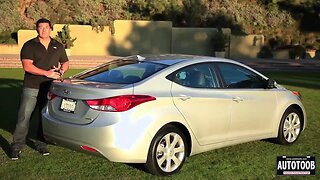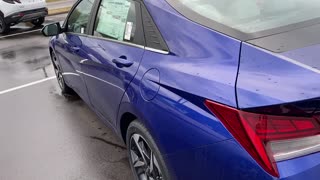NEW HYUNDAI ELANTRA 2024 #hundai #elantra #2024 #car_2024
NEW HYUNDAI ELANTRA 2024 #hundai #elantra #2024 #car_2024
Compact sedans such as the 2024 Elantra are widely viewed as basic transportation—great for first-time car buyers, fuel-efficient, and easy to park in tight spots—but the Hyundai also brings a ton of style and a whole lot of value. The sharp exterior design turns heads but the Elantra doesn't skimp on traditional compact-car traits. Its cabin is spacious for its size and an available hybrid powertrain boosts the Elantra's fuel-sipper cred. The base powertrain is a breathless 2.0-liter four-cylinder, but the N-Line model comes with a turbocharged 1.6-liter that offers a bit more zest. Even so, none of the Elantra models will raise its driver's pulse. Its handling is less entertaining than rivals such as the Honda Civic and the Mazda 3, both of which offer crisper steering and a more agile overall feel. For performance-oriented drivers, the full-on Elantra N model (reviewed separately) is far more satisfying than the regular Elantra, but it also costs a lot more.
Hyundai's compact car has been facelifted with a sharper-looking front end, updated exterior lighting elements, and new wheels. There are several new color choices, including Exotic Green and Ultimate Red. Hyundai has also added rear side-impact airbags and a rear-seat seatbelt reminder as standard across the Elantra range. Lane-keeping assist, blind-spot monitoring, and rear cross-traffic alert—all of which are standard features—now alert the driver with haptic pulses in the steering wheel.
The standard nonhybrid Elantra powertrain is a naturally aspirated 2.0-liter four-cylinder engine that pushes out a not-very-exciting 147 horsepower and 132 pound-feet of torque under the hood of SE and SEL models. Opting for the sportier N Line model drops displacement to 1.6 liters and adds a turbocharger, resulting in a much livelier 201 horsepower and 195 pound-feet of torque. The hybrid models also utilize a 1.6-liter four-pot but it’s paired with an electric motor rather than a turbo, which results in slightly less horsepower than the base engine at 139 but more torque at 195 pound-feet–equal to that of the N Line. The SE and SEL’s base 2.0-liter engine is mated to a CVT (continuously variable transmission) while the N Line, Blue Hybrid, and Limited Hybrid models get a DCT (dual-clutch transmission). Notably, the N Line gets a seven-speed DCT compared to the hybrids’ six-speed DCT. The hottest, enthusiast’s pick of the Elantra line by far is the performance-oriented N, which we review separately. But those who can't quite stomach that car's price tag could consider the tamer N Line model. After a brief test drive, we came away impressed with the N Line's perkier acceleration and its adept handling, which ups the athleticism without compromising the ride.
The EPA estimates the Elantra with the 2.0-liter four-cylinder will earn up to 33 mpg in the city and 42 mpg on the highway. Models with the turbocharged 1.6-liter four have estimates as high as 28 mpg city and 36 highway. The thriftiest hybrid Elantra is rated at 53 mpg city and 56 highway. On our 75-mph highway fuel-economy route, which is part of our extensive testing regimen, the Elantra hybrid managed only a 48-mpg result while the nonhybrid Limited with the base engine netted 38 mpg. By comparison, a Corolla hybrid hit 56 mpg in our highway test. For more information about the Elantra's fuel economy, visit the EPA's website.
To match its dramatic exterior, the cabin of the Elantra looks appropriately futuristic. The dashboard and center console wrap around the driver while the passenger's side takes a more minimalist approach. A single LED strip follows the dashboard-spanning air vent across the width of the car from the steering column to the passenger's-side door panel. Passenger volume is generous, particularly in the rear seat, which helps the Elantra compete with roomier rivals such as the Sentra and the Volkswagen Jetta. It’s not as luxurious as it looks in photos, though; there’s plenty of hard plastic inside, which isn’t surprising in this price class. In our testing, the Elantra fit six carry-on suitcases inside its trunk.
An optional 10.3-inch digital gauge display rubs elbows with a second 10.3-inch infotainment touchscreen that sprouts from the top of the Elantra's dashboard. The standard infotainment setup is an 8.0-inch center display and analog gauges for the instrument cluster. Hyundai's latest infotainment interface takes center stage here. Apple CarPlay and Android Auto are both standard, as is a Wi-Fi connection. A voice-recognition feature allows the driver to adjust things such as the climate control or the heated seats by simply uttering specific phrases. A six-speaker stereo is standard, but Limited and N-Line trims come with an eight-speaker Bose stereo instead.
-
 0:06
0:06
Vebtorque
1 year ago2023 Hyundai Elantra S Model $25000cad
2 -
 19:00
19:00
Jimmy's Outlet
10 months agoOil Change - 2016 Hyundai Elantra
108 -
 2:39
2:39
TheDriversSeat
13 years ago2011 Hyundai Elantra Review
-
 15:00
15:00
Sons of Speed
2 years ago $0.01 earnedHyundai Elantra N and Kona N - FULL TRACK REVIEW!
38 -
 1:52
1:52
Paul_Roman
1 year ago2017 Hyundai Elantra - Channel Introduction
10 -
 0:09
0:09
BlueRoseKay
1 year ago2023 Hyundai Elantra
27 -
 2:01
2:01
TheDriversSeat
5 years agoHow to buy a NEW 2018 Hyundai Elantra for $12,000
2 -
 15:41
15:41
The Car Channel For Drivers
1 year agoRACING DRIVER REVIEW: 2022 Hyundai Elantra N
39 -
 3:25
3:25
TheDriversSeat
11 years ago2013 Hyundai Elantra GT Review
8 -
 1:12
1:12
TDBULLSHIT
1 year agoMOSCOW, IDAHO 4 UPDATE: *This car IS NOT a Hyundai Elantra! LOOK
41